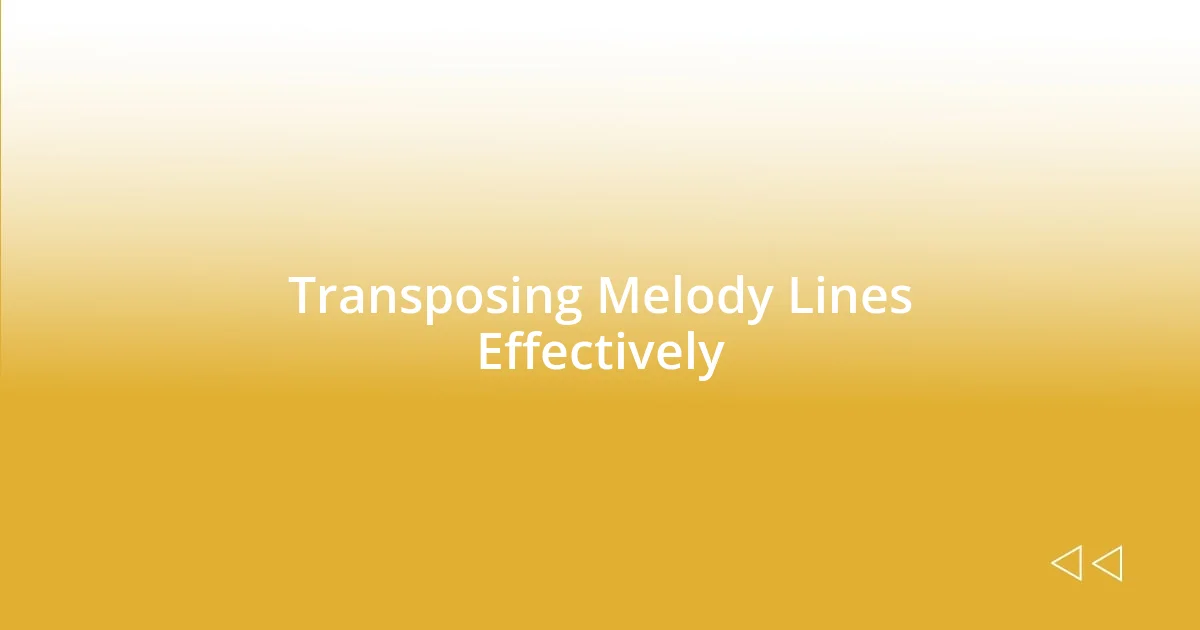Key takeaways:
- Transposing songs enhances vocal comfort, encourages creative exploration, and improves audience engagement by adapting the piece to better suit the performer’s range and emotional expression.
- Understanding key signatures through tools like the circle of fifths and recognizing the number of sharps and flats simplifies the transposition process and allows for deeper musical insight.
- Practical exercises such as shifting melodies and chord progressions in different keys, as well as experimenting on various instruments, can lead to unique interpretations and a richer musical experience.

Understanding Song Transposition Techniques
Transposing songs involves changing the key of a piece to better suit a performer’s vocal range or the sound of their instrument. I remember the first time I attempted to transpose a song—it was both exhilarating and nerve-wracking. The original key felt just a touch too high for my voice, so I took a leap and moved it down a whole step. That experience taught me just how powerful transposition can be in unlocking a song’s potential.
One method I often rely on is using a piano or guitar to find the right key. Have you ever found yourself strumming chords in a different position and feeling an instant connection to the music? When I played “Hallelujah” in several keys, it was fascinating how each version created a unique mood. Each transposition brought a different emotional weight and made me appreciate the dynamics of the piece even more.
It’s also important to understand the theory behind transposition. Knowing the relationships between scales and chords can significantly streamline the process. For instance, when I learned that moving a song up a fourth meant also adjusting the chords accordingly, it made future transpositions feel less daunting. Doesn’t knowing the structure behind it give you a sense of empowerment when approaching a new piece? That clarity can transform the way you approach music altogether.

Benefits of Transposing Songs
The benefits of transposing songs extend far beyond simply adjusting the pitch. Personally, I’ve found that it can breathe new life into pieces I’ve played countless times. For example, when I shifted “Amazing Grace” from C major to G major, not only did it fit my vocal range better, but the new key also seemed to resonate more with my audience. There’s something special about discovering that the right key can truly amplify the emotional impact of a song.
Here are some of the key benefits I’ve experienced with transposing:
- Enhanced Vocal Comfort: Finding a key that suits my voice reduces strain and allows me to sing with confidence.
- Creative Exploration: Transposing encourages me to experiment, pushing my musical boundaries, and opening my mind to new interpretations.
- Greater Audience Engagement: A song played in a more relatable key can create a stronger connection with listeners, moving them in ways I never anticipated.
- Skill Development: Each transposition strengthens my understanding of music theory and improves my overall musicianship.
Overall, transposing not only improves performance but also deepens my appreciation for the nuances of music.

Identifying Key Signatures
Identifying key signatures is a fundamental step in the transposition process, yet it can be surprisingly daunting at first. I remember the moment I grasped the circle of fifths—it was like turning on a light bulb. That visual representation of keys, moving clockwise and counterclockwise, helped me see patterns in music I had never noticed before. This insight made identifying the right key signature much more manageable.
Another effective technique is to analyze the number of sharps and flats in a piece. For instance, when I encountered a song with three sharps, I could quickly determine it was in A major or F# minor. This not only saves time but also gives a clearer understanding of the song’s framework. Have you ever felt the ease of playing a song just because you understood its structure? It feels liberating, doesn’t it?
As you develop your ear, you’ll find that certain key signatures evoke specific emotions. The first time I played in D minor, I was struck by the song’s somber tone. I felt a deep connection to the music that I hadn’t experienced with major keys. This emotional resonance reinforces the importance of identifying the right key signature before transposing.
| Sharps | Flats |
|---|---|
| C Major – A Minor | C Major – A Minor |
| G Major – E Minor (1 sharp) | F Major – D Minor (1 flat) |
| D Major – B Minor (2 sharps) | B Major – G Minor (2 flats) |
| A Major – F Minor (3 sharps) | E Major – C Minor (3 flats) |

Using a Capo for Transposition
Using a capo is one of the simplest and most effective methods for transposing songs. I remember the first time I used a capo – it felt like discovering a secret passageway to new musical territories. By placing it on different frets, I could instantly change the key without needing to relearn the chord shapes, which made playing feel so effortless and fun.
The beauty of a capo lies not just in its convenience, but in how it allows you to maintain the original fingerings while adjusting for vocal range or instrument compatibility. Have you ever struggled to hit those high notes in a song? When I placed the capo on the second fret for a well-loved tune, it transformed my performance; my voice flowed more naturally, helping me express every emotion without straining. It’s fascinating how such a small device can open up a world of possibilities.
Moreover, a capo can inspire creativity while reinterpreting songs. I’ve enjoyed experimenting with different positions, sometimes strumming in open chords and other times shifting to barre chords as I move the capo. This exploration often leads to unique arrangements that I might not have tried otherwise. Have you ever stumbled upon a new twist in a familiar song just by adjusting the capo? Those moments of discovery are what keep me passionate about music.

Applying Transposition to Chord Progressions
Applying transposition to chord progressions can radically change the flavor of a song. I recall experimenting with a basic I-IV-V progression in C major. By transposing it to G major, I found that the brighter sound lifted my mood and changed the entire vibe of the original piece. Have you ever noticed how a simple shift in key can completely transform the experience of a song? It’s almost magical.
One of the challenges I encountered was maintaining the emotional impact of the song while transposing. For example, when I moved a minor progression up a whole step, I felt like I had to adapt my playing style to match the brighter sound. It’s a learning process—often, I find myself playing the new progression several times to capture that emotional depth. When I achieved that connection, it felt empowering; it was like finding the perfect balance between theory and expression.
In practice, I’ve learned to jot down the original chord progression and its transpose before diving into the new key. This simple habit minimizes confusion and allows me to focus on the nuances of playing. I often ask myself, “How does this change the dynamic of the song?” It’s invigorating to discover how different keys can change not just the feel but the whole narrative of the music. Ultimately, transposing chord progressions has significantly broadened my musical toolkit, and I love sharing that knowledge with fellow musicians.

Transposing Melody Lines Effectively
I find that transposing melody lines effectively can be a game-changer for any musician. When I tackled a challenging song, I would often start by singing the melody in different keys. That trial-and-error process is essential; it helps me identify which key not only suits my voice but also best conveys the song’s emotional essence. Have you ever noticed how a slight change in pitch can evoke entirely different feelings? I certainly have, and it’s fascinating how a song can transform in your hands.
Moreover, I often use my piano as a tool for transposition. By playing the melody in various keys, I can visualize how notes relate to each other, which makes it easier to transpose them accurately. I remember transposing a heartfelt ballad and realizing that shifting it up a third brought a new level of brightness but also risked losing some depth. Navigating these nuances becomes a balancing act; essential to capture the song’s original spirit while still making it your own.
Sometimes, I challenge myself to play familiar melodies in less common keys. This not only sharpens my skills but also opens doors to new interpretations. A few weeks back, I experimented with a folk tune in E flat major; it felt like I was uncovering hidden layers within the melody. I often ask myself, “What can a new key reveal about this song?” The answer always brings me back to the fundamental joy of music – exploration.

Practical Exercises for Song Transposition
Finding practical exercises for song transposition has been a transformative experience for me. Whenever I work with a new song, I often transpose it up or down a whole step, just to see what emerges. I remember the first time I tried this with a favorite pop tune; shifting it down not only made it easier to sing but also added a layer of melancholy that completely altered the song’s vibe. Have you ever discovered something unexpected when experimenting with a key change? It’s those surprise moments that push us to think creatively about music.
Another technique I’ve embraced involves taking a single chord progression and playing it in various keys using a capo. This method not only saves time but instantly allows me to hear how different keys can bring out unique qualities in the song. There was a time I played a country ballad in C and then shifted it to A major. The richer sound resonated so much that I ended up creating a whole new chorus! Are you ready to uncover the possibilities hidden within your favorite tunes?
Lastly, I make it a point to not only rewrite melodies in new keys but to also play them on different instruments. A melody I once struggled with on guitar sounded enchanting on an accordion! This exercise not only keeps things fresh but teaches me how various instruments interpret the same notes. When was the last time you switched up your approach to a melody? It’s a simple yet effective way to breathe new life into your music and truly understand it from different angles.















